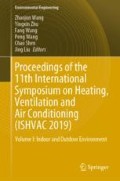Abstract
This study collected samples from 93 residential buildings in Shanghai. Based on the change of CO2 concentrations measured in these samples, we have analysed the relationship between bedroom air infiltration ratio and the residential characteristics during night, when doors and windows were closed, from 00:00 a.m. to 6:00 a.m.. The result shows that the average CO2 concentration in the bedrooms was 1448 ppm at night. CO2 concentrations from 89.2% of the tested bedrooms were higher than the upper CO2 level required by GB/T18883-2002 (over 1000 ppm). Analysis of variance shows significant factors affecting the bedroom air infiltration ratio at night including the type of window, season, gap-length of doors and windows, and type of residence. These four factors rank according to Spearman correlation analysis as follows: window type, detection season, door and window gap length, residential type. This paper is significant for its guidance on keeping the balance between building energy consumption and indoor air quality.
Access this chapter
Tax calculation will be finalised at checkout
Purchases are for personal use only
References
Wallace, L.A., Emmerich, S.J., Howard-Reed, C.: Continuous measurements of air change rates in an occupied house for 1 year: the effect of temperature, wind, fans, and windows. J. Expo. Environ. Epidemiol. 12(4), 296–306 (2002)
Shinohara, N., Kataoka, T., Takamine, K., et al.: Distribution and variability of the 24-h average air exchange rates and interzonal flow rates in 26 Japanese residences in 5 seasons. Atmos. Environ. 45(21), 3548–3552 (2011)
Ipbüker, C., Valge, M., Kalbe, K., et al.: Case study of multiple regression as evaluation tool for the study of relationships between energy demand, air tightness, and associated factors. J. Energy Eng. 4, 16–27 (2016)
Huang, C.: Building Environmental Science (2nd edn). Mechanical Industry Press (2016)
Persily, A.K.: Evaluating building IAQ and ventilation with indoor carbon dioxide. Ashrae Trans. 2, 103–110 (1997)
Quality A: Standard Guide for Using Indoor Carbon Dioxide Concentrations to Evaluate, Astm (2002)
ASHRAE: ASHRAE Handbook-Fundamentals. American Society of Heating, Refrigerating and Air-Conditioning Engineers, Atlanta, GA (2013)
Šťávová, P.: Experimental Evaluation of Ventilation in Dwellings by Tracer Gas CO2. Czech Technical University in Prague Faculty of Mechanical Engineering Department of Environmental Engineering (2011)
GB/T18883-2002: Indoor Air Quality Standards. China Standard Press, Beijing (2002)
Acknowledgements
This work is financially supported by the National Key Research and Development Program of China (2017YFC0702700), National Natural Science Foundation of China (51708347) and Shanghai Sailing Program (17YF1412800, 18YF1418200). Informed consent was obtained from all individual participants included in this study and appropriate permissions from residences owner were obtained for our study.
Author information
Authors and Affiliations
Corresponding author
Editor information
Editors and Affiliations
Rights and permissions
Copyright information
© 2020 Springer Nature Singapore Pte Ltd.
About this paper
Cite this paper
Huang, C., Zhang, Q., Qing, Z., Su, C., Zou, Z. (2020). Association between Nighttime Air Infiltration of Bedroom and Characteristics of Residential Building in Shanghai. In: Wang, Z., Zhu, Y., Wang, F., Wang, P., Shen, C., Liu, J. (eds) Proceedings of the 11th International Symposium on Heating, Ventilation and Air Conditioning (ISHVAC 2019). ISHVAC 2019. Environmental Science and Engineering(). Springer, Singapore. https://doi.org/10.1007/978-981-13-9520-8_68
Download citation
DOI: https://doi.org/10.1007/978-981-13-9520-8_68
Published:
Publisher Name: Springer, Singapore
Print ISBN: 978-981-13-9519-2
Online ISBN: 978-981-13-9520-8
eBook Packages: Earth and Environmental ScienceEarth and Environmental Science (R0)

